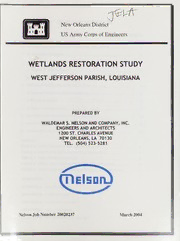
Wetlands Restoration Study: West Jefferson Parish, Louisiana PDF
Preview Wetlands Restoration Study: West Jefferson Parish, Louisiana
New Orleans District US Army Corps of Engineers WETLANDS RESTORATION STUDY WEST JEFFERSON PARISH, LOUISIANA PREPARED BY WALDEMAR S. NELSON AND COMPANY, INC. ENGINEERS AND ARCHITECTS 1200 ST. CHARLES AVENUE NEW ORLEANS, LA 70130 TEL. (504) 523-5281 Nelson Job Number 20020237 March 2004 U Digitized by the Internet Archive in 2012 with funding from LYRASIS Members and Sloan Foundation http://archive.org/details/wetlandsrestoratOOwald 1 TABLE OF CONTENTS PAGE No. INTRODUCTION 1. 1 POTENTIAL SOURCES OF TREATED EFFLUENT 4 2. a) Alternatives Evaluated 4 b) Characteristics ofEffluent 5 c) Current Situation in Parish 7 d) Recommended Project 9 DETAILED WETLAND UNIT SELECTION 3. 11 a) National Park Service Recommendations 1 b) On-Site Inspection 11 c) Remote Sensing Analysis 17 4. ROUTING AND REVISED COST ESTIMATES 20 5. ENVIRONMENTAL DOCUMENTATION/PUBLIC OUTREACH 23 6. SUMMARY AND CONCLUSIONS 27 TABLES: TABLE 1: UNIT COSTS FOR EACH ALTERNATIVE 4 TABLE COSTS FOR EACH PROJECT ALTERNATIVE 2: 5 TABLE 3: PARAMETER LOADINGS 6 TABLE 4: FIELD TRIP VS REMOTE SENSING CONCLUSION 19 TABLE 5: COST SUMMARY FOR EACH PROJECT ALTERNATIVE 22 APPENDICES: APPENDIX A: BACKGROUND APPENDIX B: CASE STUDIES APPENDIX C: NVISION'S REPORT APPENDIX D: COST ESTEVIATE APPENDIX E: ENVIRONMENTAL REPORT 3 APPENDIX F: MEMOS FROM NPS MEETINGS EXHIBITS: EXHIBIT DRAWING NO.C1 1: EXHIBIT DRAWING NO.C2 2: EXHIBIT 3: DRAWING NO.C INTRODUCTION 1. Thousands of acres of wetlands comprising the upper reaches of the Barataria Basin flank the west bank of the Mississippi River in Jefferson Parish, Louisiana. These wetlands are valued for their fisheries and recreational value as well as their ability to protect the inhabited areas of the Parish from storm surges. The wetlands in this area are being stressed and functionally degraded or lost as a direct result of human activities that have limited traditional sources of fresh water and nutrients, and by the effects of subsidence. Historically, flows from the Mississippi River provided the fresh water, nutrients and sediments needed to maintain healthy wetlands, and counteract the natural subsidence associated with deltaic systems. Construction of flood and hurricane protection levees has eliminated the interconnection between the River and the wetlands. As a consequence, subsidence and salt water intrusion have degraded the vigor ofthe vegetative communities, and these wetlands are transitioning to open water. An annually occurring hypoxic zone, an area in the Gulf of Mexico of low oxygen content, has been occurring in the Gulf westward from the mouth of the Mississippi River. This hypoxic zone has been attributed to high quantities of nutrients entering the Gulf from the Mississippi River. The nutrients enter the River from a variety of sources including primarily agricultural and urban stormwater runoff and, to a lesser extent, from direct discharge from a large number of wastewater treatment facilities. Jefferson Parish's West Bank wastewater treatment facilities currently discharge treated wastewater effluent into the Mississippi River. Limits are likely to be imposed in the future on nutrient discharges into the Mississippi River, which could lead the Parish to alter its current treatment processes, possibly requiring additional treatment processes to accomplish nutrient removal. From a regulatory view, the State of Louisiana and the Federal government have begun the process of addressing wetlands loss and the hypoxic conditions in the Gulf of Mexico. Future limits on nutrient discharges to the Mississippi River may require a 30 percent reduction. Jefferson Parish is already in the process of preparing a long-term strategy for wastewater treatment on the Parish's West Bank to address the need for added capacity associated with projected population growth. Federal, state and local planners have found that wetlands restoration techniques that use treated municipal wastewater effluent as a source of fresh water and nutrients have been proven to be safe and effective in Louisiana and elsewhere in the nation. Thus, the need to address wetlands degradation and excess nutrients in the Mississippi River, and the Parish's need to chart a long term course for its wastewater treatment program have combined to make it an opportune time to evaluate an alternative that has the potential for addressing all three needs. Jefferson Parish and the U.S. Army Corps of Engineers, New Orleans District (USACE NOD) have conducted a joint study to define the technical and cost feasibility associated with a project designed to both restore the health of wetlands and to assist in the Parish's long term wastewater treatment needs. The study evaluates the potential of recycling the treated wastewater effluent by utilizing it as a source of fresh water and nutrients for wetlands on the west bank of the Mississippi River in Jefferson Parish. This Phase 2 report continues the documentation of the study done to evaluate the feasibility of wetlands restoration in West Jefferson Parish, Louisiana through the application of treated municipal wastewater. Phase 1 of the study was completed in January 2003 with the issuance of a report evaluating the overall feasibility of the concept. The first phase feasibility analysis was conducted to determine the technical, economic and environmental feasibility of using treated municipal sewage for the puipose of wetland restoration on the west bank of Jefferson Parish, Louisiana. That report concluded that there were adequate acreage of wetlands in west Jefferson Parish in need of restoration and recommended that additional analysis be conducted. This second phase report takes a more detailed look at the feasibility and targets specific sources of water and specific wetlands to be restored. Updated cost estimates are also presented in this report.
